Notícias do Mercado
-
23:53
Japan BSI Large Manufacturing Conditions Index (QoQ) below expectations (0.1) in 4Q: Actual (-3.6)
-
23:52
GBP/JPY finds cushion around 167.30 as focus shifts to UK Inflation and BOE policy
- GBP/JPY is gauging support around 167.30 amid expectations of an extension in BOE/BOJ policy divergence.
- The BOE is bound to sound hawkish despite the economy falling into recession.
- Food price inflation in the UK economy is propelling consensus for headline CPI figures.
The GBP/JPY pair is gauging demand after dropping to near 167.30 in the early Asian session. The cross witnessed selling pressure after failing to cross the round-level resistance of 168.00. Meanwhile, the GBP/USD pair has corrected ahead of Federal Reserve (Fed)’s monetary policy, portraying a cautious market mood.
The cross is likely to recover sharply as the Bank of England (BOE)-Bank of Japan (BOJ) policy divergence is expected to escalate further after an interest rate hike by the United Kingdom central Bank in its last monetary policy meeting of CY2022 on December 15.
A poll on Bank of England’s interest rate hike expectations taken by Reuters states that the central bank will add another 50 basis points (bps) next week and take borrowing costs to 3.50%, despite the economy falling into recession. The rampant inflation in the United Kingdom needs further policy tightening to bring exhaustion in the inflationary pressures.
But before that, investors will focus on the UK’s inflation data, which will release on Wednesday. As per the projections, the annual inflation data for November is expected to accelerate to 11.5% vs. the prior release of 11.1%. Thanks to the fresh rise in food price inflation led by the food supply crisis amid a shortage of labor and higher input cost, which has strengthened higher expectations for the headline inflation data.
On the Tokyo front, the risk of a decline in inflation has been triggered after a contraction in Gross Domestic Product (GDP) numbers. A subdued demand never propels a hike in the price rise index. Bank of Japan (BOJ) Haruhiko Kuroda is of the view that even if wages rise by 3%, the BOJ will maintain its current easy policy until inflation reaches 2%.
-
23:51
EUR/JPY Price Analysis: Teases bears below 144.00
- EUR/JPY remains sidelined after snapping two-week downtrend.
- Lower high formation joins sluggish RSI to tease bears, 50-SMA restricts immediate downside.
- 200-SMA, seven-week-old descending trend line appear tough nuts to crack for bulls.
EUR/JPY treads water around 143.80 as bulls take a breather after posting the first weekly gain in three.
However, the lower highs in the last weeks and the RSI line’s retreat signal that the bullish momentum isn’t strong.
As a result, the pair sellers could aim for the 50-SMA level surrounding 143.15, a break of which could poke the 143.00 round figure.
In a case where EUR/JPY bears keep the reins past 143.00, the previous monthly low near 142.55 and the latest trough near 140.75 may probe the downside moves to target the 140.00 threshold.
Alternatively, recovery moves may initially confront the 200-SMA level of 144.77 before challenging a downward-sloping trend line from October 21, close to 144.90 at the latest.
Following that, the highs marked in late November around 146.15 could act as the last defense of the EUR/JPY bears.
Should the quote remains firmer past 146.15, the odds of witnessing a run-up towards the yearly top marked in October, around 148.40, can’t be ruled out.
Overall, EUR/JPY is likely to witness further hardships but the south run appears more lucrative than the upside momentum.
EUR/JPY: Four-hour chart

Trend: Further downside expected
-
23:50
Japan Producer Price Index (YoY) came in at 9.3%, above expectations (8.9%) in November
-
23:50
Japan Producer Price Index (MoM) above expectations (0.5%) in November: Actual (0.6%)
-
23:31
EUR/USD stays defensive above 1.0500 with eyes on US Federal Reserve, European Central Bank
- EUR/USD struggles for clear directions after snapping two-week uptrend.
- Recently firmer statistics from United States challenge Euro pair buyers.
- Federal Reserve, European Central Bank both are up for 0.50% bps rate hike actions.
- The central bank’s signals for future moves will be crucial for EUR/USD traders, monthly PMIs, US inflation eyed too.
EUR/USD treads water around 1.0530 as the bumper week begins, having witnessed the first weekly loss in three.
In doing so, the major currency pair portrays the typical cautious mood ahead of the key monetary policy meetings of the Federal Reserve (Fed) and the European Central Bank (ECB). Also important to watch are the preliminary readings of the November month’s activity data from Europe and the United States, not to forget the US inflation numbers. It’s worth noting that the recently firmer US economics and doubts over the Eurozone economic recovery seem to challenge the EUR/USD bulls after two consecutive weeks of the uptrend.
Data from United States, Europe challenge EUR/USD bulls
Not only Friday’s US Producer Price Index (PPI) and Consumer Sentiment Index from the University of Michigan (UoM) but the US ISM Services PMI and inflation expectations also flashed upbeat outcomes in the latest announcements. However, European economics aren’t that good and hence keep the Euro bears hopeful.
That said, US Producer Price Index (PPI) matched the market forecasts of 7.4% YoY for November versus 8.1% prior. Further, the Core PPI rose to 6.2% YoY versus 6.0% expected and 6.7% previous readings. Additionally, preliminary readings of the University of Michigan’s (UoM) Consumer Sentiment Index rose to 59.1 for December versus 53.3 market forecasts and 56.8 final readings for November. Moreover, the 1-year inflation expectations dropped to 4.6%, the lowest since September 2021 while compared to 4.9% expected whereas 5-10 year expectations were stable at 3.0%. It should be noted that the US ISM Services PMI improved to 56.5 versus 54.4 expected. As a result, the US Dollar Index (DXY) printed the first weekly close on the positive side in the last three.
On the other hand, the final readings of the S&P Global Eurozone PMIs for November witnessed a downward revision while Retail Sales for the bloc also dropped by 1.8% MoM and 2.7% YoY. It should be observed that the Eurozone GDP for the third quarter (Q3) improved to 0.3% versus the initial estimations of 0.2%. Amid these plays, the Euro struggles for major directions and lost the upside momentum.
Federal Reserve appears more hawkish than European Central Bank
Although the US Federal Reserve (Fed) and the European Central Bank (ECB) are both likely to announce a 0.50% rate increase, the recently firmer US data and the latest comments from the policymakers suggest that the Fed will be more hawkish than the ECB.
That said, the discussions surrounding the Quantitative Tightening (QT) might be of interest for the US Dollar traders when it comes to the Fed, as they’ve already teased the ‘pivot’. Should the policymakers suggest such moves, the EUR/USD pair may witness a reversal of the latest gains.
ECB, on the other hand, will have to defend the growth expectations and balance the announcements surrounding the QT to keep the Euro bulls on board. That said, discussions surrounding the pandemic emergency purchase programme (PEPP) and asset purchase programme (APP) of the European Central Bank will be crucial for the EUR/USD pair buyers to watch.
Considering this, analysts at ANZ said, “Following the very rapid tightening in policy rates this year, we expect the FOMC, ECB and BoE will scale back the magnitude of rate hikes to 50bp but reaffirm that they remain determined to bring inflation back to target and will take the appropriate and necessary steps to achieve that.”
Too many things to watch for EUR/USD traders
Other than the monetary policy decisions from the ECB and the Fed, monthly inflation data from the United States and the December month’s preliminary activity numbers for Europe and the US will also be important for the Euro traders to watch. Forecasts suggest an overall firmer outcome of the US data than the ones from Europe, which in turn could help the EUR/USD pair bears to keep the reins. However, major attention will be given to the ECB versus Fed drama for clear directions.
US recession, EU-Russia tension are extra catalysts
Other than the aforementioned signals, the EUR/USD pair will also need to take care of the headlines surrounding the United States recession and the latest tension between Russia and Europe to aptly determine the short-term performance. That said, the growing fears of the US recession may allow the EUR/USD bulls to try one more time but the geopolitical fears may underpin the US Dollar’s safe-haven demand and can favor the EUR/USD pair buyers.
EUR/USD technical analysis
EUR/USD portrays a double top formation around 1.0585-95, which in turn joins the recent retreat of the Relative Strength Index (RSI) line, placed at 14, to challenge further upside bias for the pair.
However, a convergence of the 50-SMA and an upward-sloping support line from early November, close to 1.0500, holds the key for the EUR/USD seller’s entry.
Also acting as a short-term downside filter is the previous 1.0440, a break of which will confirm the “double top” bearish chart pattern and theoretically favors a downturn toward the 1.0280 support.
Meanwhile, the EUR/USD pair’s upside clearance of 1.0595 hurdle will need validation from the 1.0600 threshold and monthly ascending resistance line, close to 1.0635, to defend the dominance. Following that, May 2022 peak surrounding 1.0785-90 will be in focus.
Overall, EUR/USD bulls seem running out of steam but the downside needs a trigger, which in turn highlights 1.0500 support confluence.
EUR/USD: Four-hour chart

Trend: Pullback expected
-
23:21
USD/CAD bears lurking ahead of the Fed
- USD/CAD traders will be eying the FOMC and the Oil price.
- USD/CAD is riding dynamic support with a focus on 1.3700.
USD/CAD ended the week at a familiar resistance near 1.3650 as oil prices moved to fresh lows while investors got set for the Federal Open Market Committee's interest rate decision this week.
The Canadian dollar travelled between 1.3586 and 1.3691 on Friday and was down 1.2%, its second straight week of declines. Crude oil has been problematic for CAD and it fell sharply again last week amid the weakening economic backdrop.
Analysts at ANZ Ban explained that the uncertainty surrounding European sanctions on Russian oil and the related price also kept volatility high. ''Newly implemented European sanctions on Russia oil have had little impact on the oil market so far. The relatively high price cap eased concerns that Russian supply would be curtailed even further.''
''However, prices gained briefly on Friday after Russian President Vladimir Putin warned that he may cut production in response, the analysts added.
Wall Street's main indexes have also fallen ahead of the Federal Reserve this week. Investors are in anticipation of a potential 50-basis point interest rate hike by the Fed when it announces its policy decision on Wednesday.
''We expect the FOMC to deliver a 50bp rate increase at its December meeting, lifting the target range for the Fed funds rate to 4.25%-4.50%,'' analysts at TD Securities. ''In doing so, the Committee would finally move the inflation-adjusted policy stance into restrictive territory. We also look for the FOMC to signal that they will have to move to a higher terminal rate than anticipated in September.''
USD/CAD technical analysis
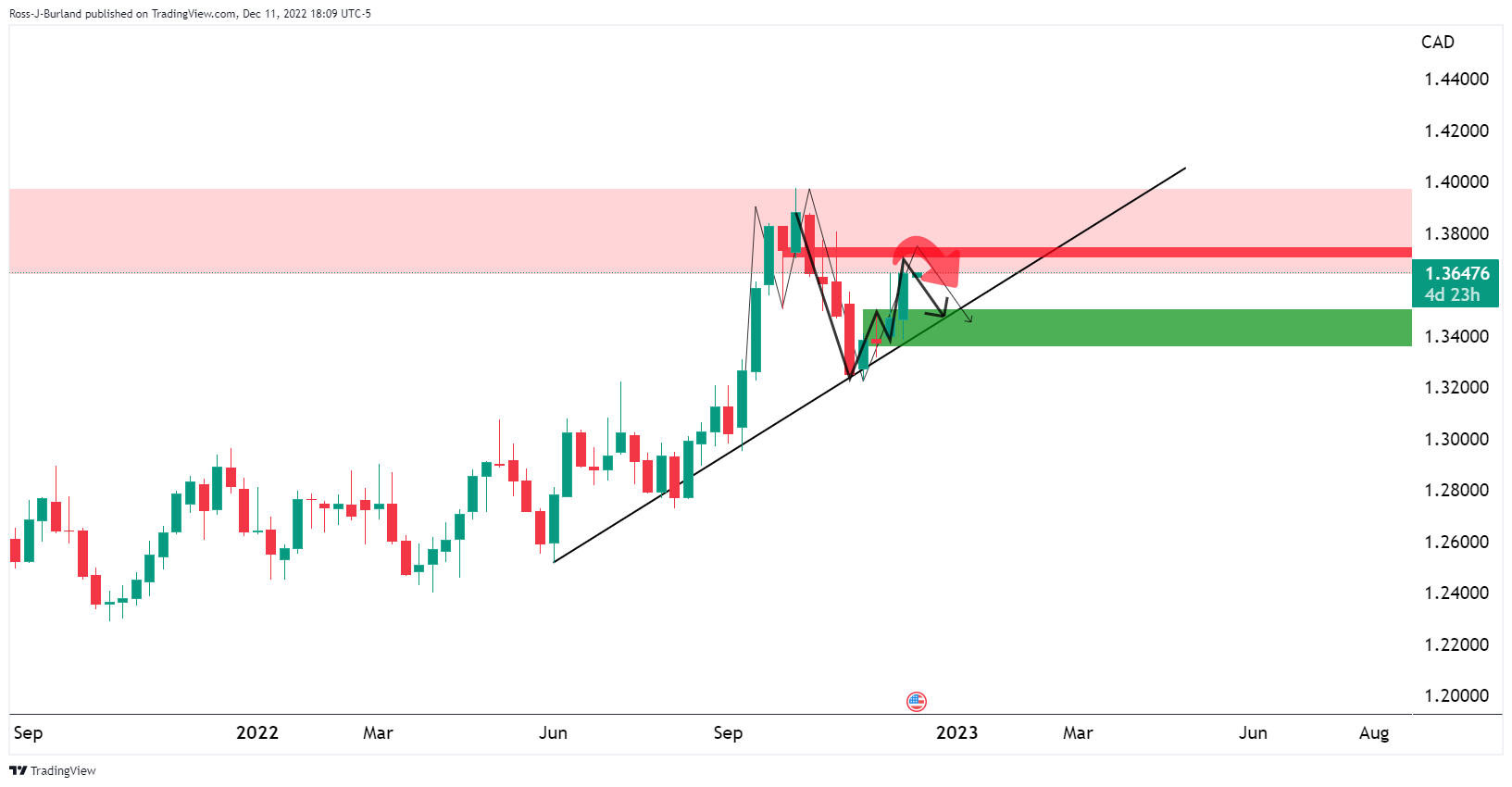
The daily chart, above, shows USD/CAD's W-formation. This is a reversion pattern so there could be opportunities for shorting into the bull trend once bearish structure has formed on the lower time frames.
For now, the price remains on the front side of the bullish dynamic support and this leaves prospects of a continuation in the meantime. However, should the price reach into1.3700, bears will be looking for signs of deceleration and distribution.
USD/CAD H1 chart
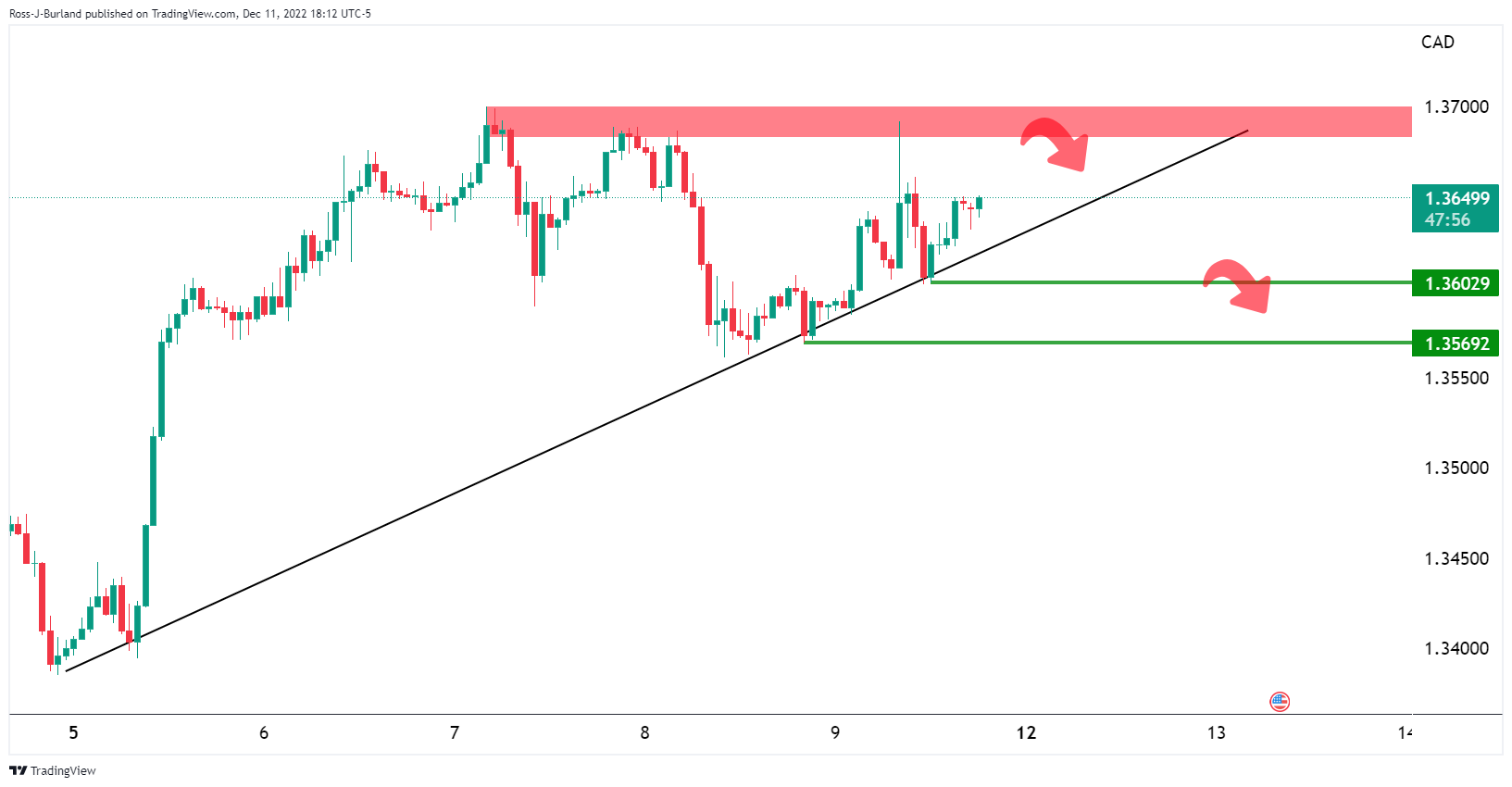
A break above 1.3700 will put the focus on 1.3800.
-
23:19
USD/CHF auctions on thin ice around 0.9340 as investors await US CPI
- USD/CHF has continued to remain sideways around 0.9340 ahead of Fed/SNB monetary policy.
- Investors expect a surprise move in November’s US Inflation report.
- The SNB is expected to continue its hawkish policy as the current monetary policy is unable to tackle inflation.
The USD/CHF pair has continued its sideways performance, settled on Friday, in the early Tokyo session as investors are awaiting the announcement of the United States Consumer Price Index (CPI) data for fresh impetus.
The Swiss franc asset is displaying topsy-turvy moves in a 0.9320-0.9380 range amid mixed responses from the risk profile. Pre-Federal Reserve (Fed) policy anxiety is turning the market mood cautious while the expectation of a deceleration in the pace of the interest rate hike by the Federal Open Market Committee (FOMC) is providing a cushion to the risk appetite theme.
S&P500 ended the week on a bearish note, reported risk aversion theme by the market participants. Meanwhile, the US Dollar Index (DXY) is struggling around 105.00 as investors expect a surprise deviation in November’s inflation report. The release of the headline US Producer Price Index (PPI) matched expectations after declining to 7.4% and has raised hopes for a decline in inflation, however, the upbeat November employment report is calling for a surprise rebound in the price pressures.
This week, the show-stopper event will be the interest rate decision by the Fed, which is scheduled for Wednesday. Rabobank analysts said they expect the US central bank to hike the policy rate by 50 basis points and see policymakers revising the terminal rate projection to the neighborhood of 5%.
On the Swiss franc front, the monetary policy meeting of the Swiss National Bank (SNB) will be of utmost importance. A commentary from SNB Chairman Thomas J. Jordan stating that their current monetary policy is too loose to tackle inflation, reported by Reuters, cements expectations for a hawkish monetary policy.
-
22:42
GBP/USD faces barricades around 1.2300 as anxiety soars ahead of Fed/BOE policy
- GBP/USD has dropped to near 1.2250 after failing to surpass the 1.2300 hurdle.
- Market mood has turned cautious ahead of monetary policy meeting season.
- The Fed is set to sound ‘less-hawkish’ amid a decline In October’s inflation report and in line PPI numbers.
The GBP/USD pair has corrected to near 1.2250 after facing hurdles near the round-level resistance of 1.2300 in the early Asian session. The Cable has sensed selling pressure as investors are getting anxious ahead of the release of the monetary policies by the Federal Reserve (Fed) and the Bank of England (BOE).
The US Dollar index (DXY) is failing to recapture the round-level resistance of 105.00 as investors have shifted to the sidelines amid a cautious market mood. S&P500 faced heat on Friday and is expected to remain precautionary ahead as a further rate hike by the Fed is going to escalate recession fears in the United States economy. Meanwhile, the 10-year US Treasury yields are eyeing to capture the 3.60% hurdle as expectations of a hawkish Fed policy will trim demand for US Treasury bonds.
Post a surprise fall in October’s inflation report, a decline in consumer spending, and Friday’s Producer Price Index (PPI) data, Fed chair Jerome Powell is expected to sound ‘less hawkish’ than the new normal on Wednesday. The price Index for factory-gate rates was trimmed to 7.4% in line with expectations. A decline in prices for final products indicates a decline in demand, which forced producers to go easy on decision-making for end-products prices.
On the United Kingdom front, the BOE is set to hike its interest rates further by 50 basis points (bps), according to a Reuters poll. The United Kingdom's economy is in a recession led by an extreme debt crisis, weak economic prospects, and an absence of exhaustion in inflation. The inflation rate is looking to extend further as food-price inflation is soaring dramatically after escalating food supply crisis.
-
22:42
NZD/USD Price Analysis: Bulls running out of steam above 0.6400
- NZD/USD begins the key week without much noise, grinds higher after eight-week uptrend.
- Overbought RSI conditions, six-month-old horizontal resistance challenge further advances.
- Ascending trend line from early November, previous resistance from June limit downside.
NZD/USD stays defensive above 0.6400 as traders begin the bumper week, after the bull’s dominance in the last eight consecutive weeks.
It’s worth noting, however, that the overbought conditions of the Relative Strength Index (RSI) line, placed at 14, coupled with the Kiwi pair’s repeated failures to cross the six-month-old horizontal hurdle, keep the buyers and sellers hopeful.
However, a five-week-old ascending support line, near 0.6380 by the press time, holds the key to the NZD/USD bear’s entry.
Even so, the resistance-turned-support trend line from June 03, close to 0.6290 at the latest, could restrict the Kiwi pair’s further downside.
In a case where the NZD/USD bears conquer the 0.6290 support, they can aim for September’s high surrounding 0.6160.
Alternatively, the aforementioned horizontal area comprising multiple levels marked since early June, near 0.6465-75, appears a tough nut to crack for the NZD/USD bulls. Following that, a run-up towards the mid-2022 peak surrounding 0.6575 can’t be ruled out.
Overall, NZD/USD is likely to remain inactive between 0.6465 and 0.6380. However, the pair’s further upside appears less likely.
NZD/USD: Daily chart
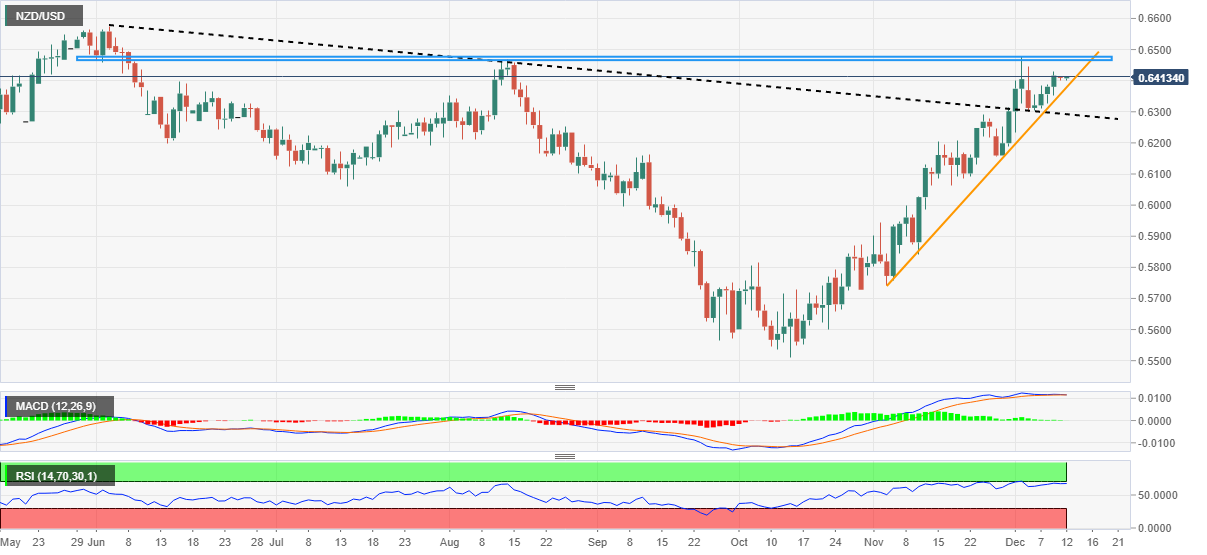
Trend: Limited upside expected
-
22:14
AUD/USD bulls flirt with 0.6800 as they seek validation from RBA’s Lowe, Fed
- AUD/USD remains sidelined after closely missing the bearish weekly close.
- US Dollar gained on upbeat data, pre-Fed anxiety and geopolitical fears.
- Aussie Dollar cheers optimism surrounding China, RBA’s positive tone.
- No major data from Australia on cards for publishing today but rest of the week will be too volatile.
AUD/USD began the key week on a dicey floor after closely missing the negative weekly print. In doing so, the Aussie pair portrays the typical pre-data anxiety ahead of the key monetary policy meeting of the US Federal Reserve, a speech from the Reserve Bank of Australia (RBA) Governor Philip Lowe and the US inflation numbers, not to forget Aussie jobs report for November. Given the slew of important catalysts lined up for publication, the Aussie pair struggles for clear directions and remains volatile.
That said, the US Dollar Index (DXY) printed the first weekly close on the positive side in the last three as the latest US economy came in better than expected.
The US Producer Price Index (PPI) matched the market forecasts of 7.4% YoY for November versus 8.1% prior. Further, the Core PPI rose to 6.2% YoY versus 6.0% expected and 6.7% previous readings. Additionally, preliminary readings of the University of Michigan’s (UoM) Consumer Sentiment Index rose to 59.1 for December versus 53.3 market forecasts and 56.8 final readings for November. Moreover, the 1-year inflation expectations dropped to 4.6%, the lowest since September 2021 while compared to 4.9% expected whereas 5-10 year expectations were stable at 3.0%.
Elsewhere, China continues to praise a reduction in the daily Covid cases and shows readiness for more stimulus. During the weekend, Nikkei Asia reported that China banks throw a $460 billion credit lifeline to the real estate sector.
At home, the RBA’s push for slower rate hikes failed to gain major acceptance as the policymakers showed readiness for stronger moves if needed. The same joins mixed data to restrict the AUD/USD moves.
Amid these plays, Wall Street closed in the red and yields improved, which in turn restricted the AUD/USD pair’s safe-haven demand and weighed on the prices ahead of the key week.
Moving on, a light calendar on Monday and a cautious mood ahead of the key data/events could restrict intraday moves of the AUD/USD pair. However, hopes of a hawkish hike by the Fed versus the RBA’s latest defense to the easy rate hike teases the pair sellers.
Technical analysis
A one-month-old bullish channel restricts short-term AUD/USD moves between 0.6870 and 0.6685 as the Aussie traders struggle to cross the 200-day EMA hurdle surrounding 0.6835.
-
22:06
Gold Price Forecast: XAU/USD eyes a break above $1,800 ahead of US Inflation
- Gold price is aiming to recapture a five-month high at around $1,800.00 as the risk-on profile is regaining traction.
- S&P500 to display wild gyrations ahead of Fed’s monetary policy meeting.
- November’s CPI could display a surprise rise as payroll additions soared.
Gold price (XAU/USD) has picked recovery after dropping marginally below $1,796.00 in the early Tokyo session. The precious metal is aiming to extend its recovery above the round-level resistance of $1,800.00 as the risk-appetite theme has regained strength. On a broader note, the risk profile could display some volatile moves as investors have shifted their focus toward the release of the US Consumer Price Index (CPI), which is scheduled for Tuesday.
Meanwhile, the US Dollar Index (DXY) is struggling to conquer the immediate resistance of 105.00 as the broader theme doesn’t support a risk-aversion mood. S&P500 showed a precautionary mood on Friday ahead of the last Federal Reserve (Fed)’s monetary policy meeting of CY2022. The US Treasury yields displayed some choppy moved but settled near 3.60% on Friday, showing cautiousness in the global market.
As per the projections, the headline CPI is expected to remain stable at 7.7%. While the core inflation could display a slight improvement to 6.4% from the former release of 6.3%. The inflationary pressures could display a surprise jump as labor demand remained extremely tight in November and the service sector is booming led by solid demand.
Gold technical analysis
On an hourly scale, Gold price is aiming to test a fresh five-month high around $1,810.00 on an hourly scale. The 20-period Exponential Moving Average (EMA) at $1,796.24 is acting as a major support to the gold price. Also, advancing 200-EMA at $1,780.00 indicates that the long-term trend is intact toward the north.
Meanwhile, the Relative Strength Index (RSI) (14) is looking to shift into the bullish range of 60.00-80.00 for activating an upside momentum.
Gold hourly chart

-
21:45
New Zealand Visitor Arrivals (YoY): 4283.8% (October) vs previous 6448.5%
-
21:07
BOJ's Takata: Japan not in phase to remove yield curve control
Reuters reported Bank of Japan board member Hajime Takata said in an interview with the Nikkei newspaper published on Saturday that Japan's economy is not yet in a phase where the central bank can end yield curve control,
He also said there were some positive signs in corporate capital expenditure and wages, according to the Nikkei.
USD/JPY update
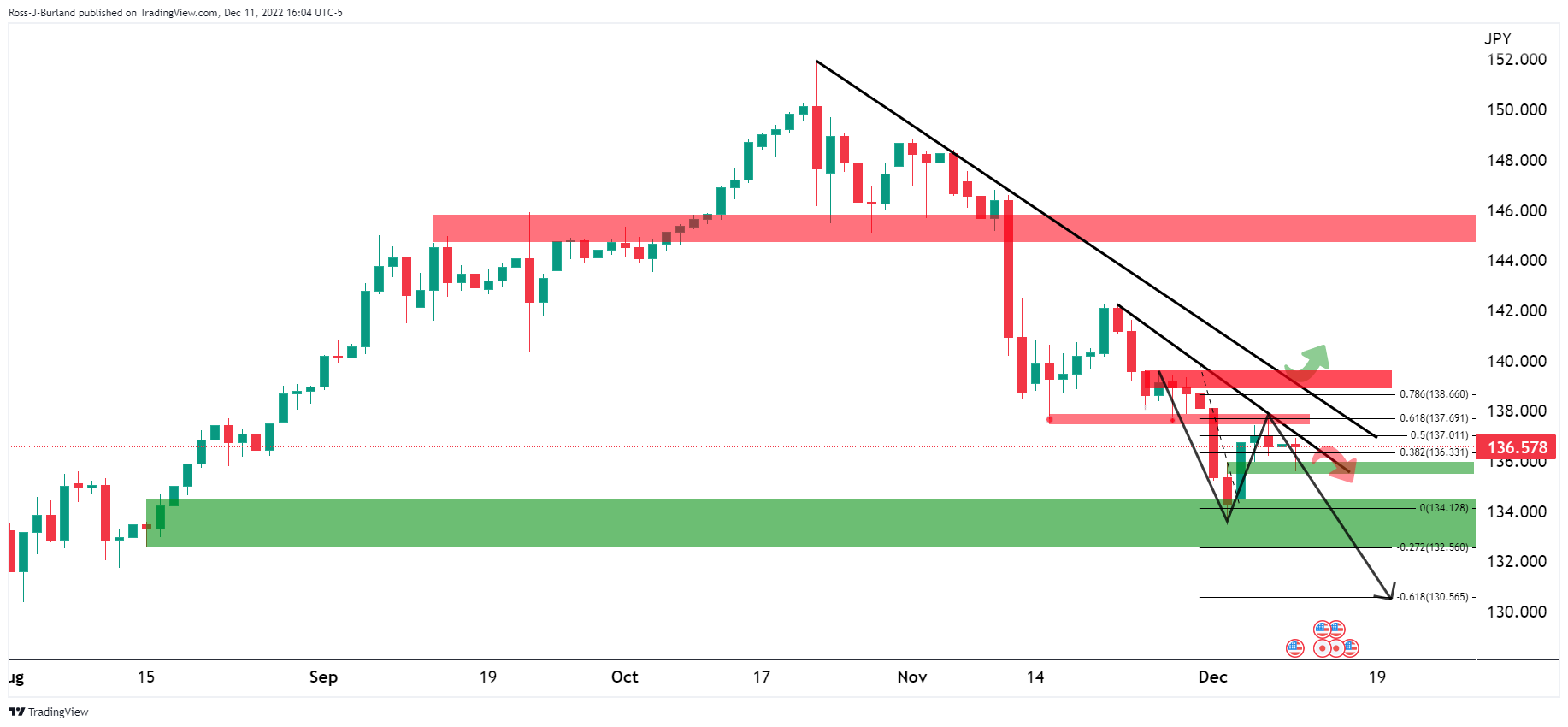
USD/JPY is a resistance area on the daily chart as the bulls move in on the 137.00s. While on the front side of the trend, there is a focus on a downside extension.
-
20:42
EUR/USD Price Analysis: Bulls eye a break of key 1.0550 area, eyes on 1.0600
- EUR/USD remains in a bullish structure with a focus on a break above 1.0600.
- The bull's first challenge will be the micro trendline resistance and the 1.0550s.
As per the prior analysis, EUR/USD bulls have committed to the course and remain on the front side of the bullish dynamic trendline support as the following will illustrate:
EUR/USD prior analysis
While on the front side of the daily trendline, it was noted that EUR/USD bulls were firming from near 1.0480 support and were taking on resistance around 1.0570.
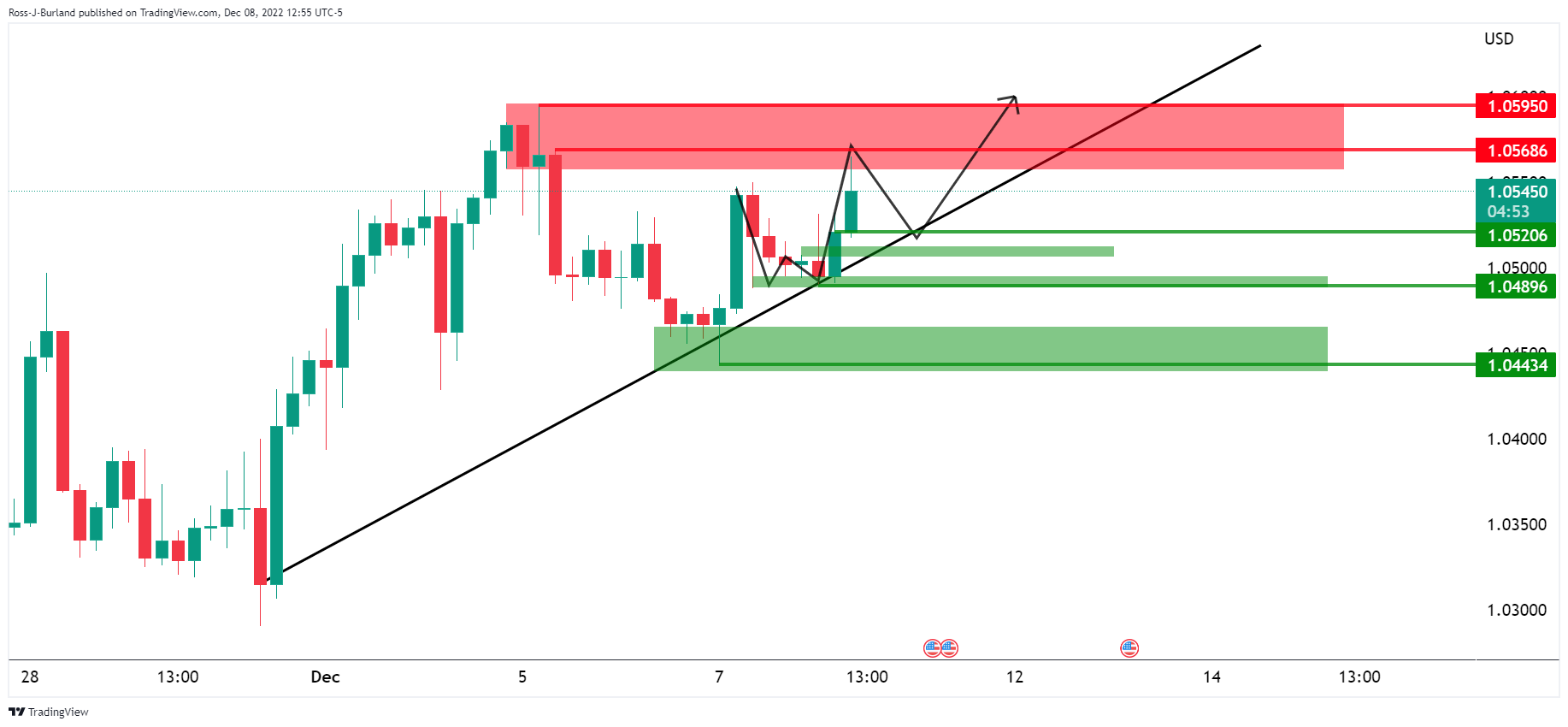
A break there has opened the risk of a move in EUR/USD beyond 1.0600.
A move in EUR/USD below the trendline and 1.0490 would open prospects of a deeper correction towards 1.0400.
EUR/USD update

The price remains in a bullish structure while holding in the 1.05s and the focus for the opening sessions is on a bullish continuation:
EUR/USD H1 chart

The bull's first challenge will be the micro trendline resistance and the 1.0550s.
-
20:07
AUD/USD Price Analysis: Bulls eye 0.6820 while riding dynamic support
- AUD/USD bulls eye the price imbalance in the 0.6820s for the open.
- A break of 0.6750, however, will open the risk of a deeper move to test bullish commitments at 0.6700.
AUD/USD ended the week on the front foot with the price marching toward its strongest levels in three months. Risk appetite was elevated on Friday which could feed through for the open, tilting the bias to the upside as per the following analysis:
AUD/USD daily chart

The price has carved out a bullish scenario and a break of 0.6800 could be on the cards for the opening sessions.
AUD/USD H1 chart

The hourly chart sees the bulls on the front side of the bullish dynamic support. Eyes are on a price imbalance in the 0.6820s for the open. A break of 0.6750, however, will open the risk of a deeper move to test bullish commitments at 0.6700.
-